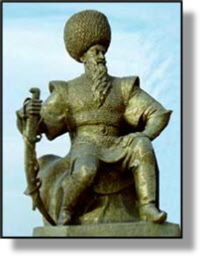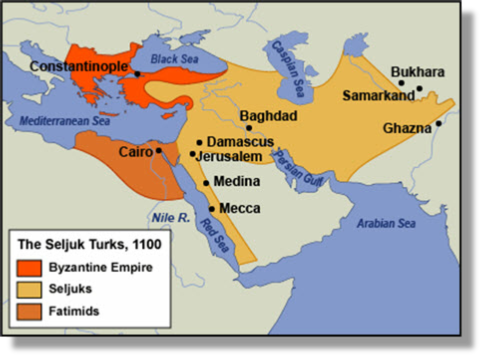


THE SELJUK TURKS WIN THE BATTLE OF MANZIKERT 1071 (W1)
xxxxxThe Seljuk Turks, a nomadic people who, by 1055, had founded a large empire centred on Baghdad, gained a major victory over the Byzantines at the Battle of Manzikert in 1071. This paved the way for their conquest of Anatolia (modern Turkey) and, within the year, the capture of Jerusalem -
 xxxxxThe Seljuk Turks, a nomadic group of fighters originating in central Asia, established themselves in the Middle East some time in the 9th century and by 1055 had founded an Islamic empire, centred on Baghdad, stretching over vast tracts of Iran, Iraq and Syria. Their defeat and capture of the Byzantine emperor Romanus IV Diogenes at the Battle of Manzikert in the year 1071 paved the way for the conquest of Anatolia (modern Turkey). Indeed, within the same year the Turks had moved south into the Christian Holy Land and taken control of Jerusalem, a city which had been in Arab hands since the seventh century.
xxxxxThe Seljuk Turks, a nomadic group of fighters originating in central Asia, established themselves in the Middle East some time in the 9th century and by 1055 had founded an Islamic empire, centred on Baghdad, stretching over vast tracts of Iran, Iraq and Syria. Their defeat and capture of the Byzantine emperor Romanus IV Diogenes at the Battle of Manzikert in the year 1071 paved the way for the conquest of Anatolia (modern Turkey). Indeed, within the same year the Turks had moved south into the Christian Holy Land and taken control of Jerusalem, a city which had been in Arab hands since the seventh century.
The Battle of Manzikert, north of Lake Van, was the culmination of years of hostility between the peoples of Asia Minor -
 xxxxxThe height of the empire's power was reached during the reign of two Sultans, Alp-
xxxxxThe height of the empire's power was reached during the reign of two Sultans, Alp-
After Malik Shah's death the Seljuk Empire went into slow decline and had lost its power by 1200. However, one branch of the dynasty managed to survive in Anatolia until the 13th century. It was here towards the end of that century that the ruler of a small principality in the north-
W1-
Acknowledgements
Alp Arslan: statue in Ashgabat, Turkmenistan, sculptor unknown. Map: licensed under Creative Commons -


